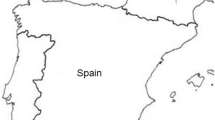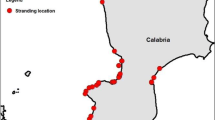Abstract
Concentrations of butyltin (BT) and phenyltin (PT) compounds were measured in organs and tissues of five species of whales (Bride’s whale [Balaenoptera edeni], false killer whale [Pseudorca crassidens], pygmy sperm whale [Kogia breviceps], short-finned pilot whale [Globicephala macrorhynchus], and sperm whale [Physeter macrocephalus]) found stranded on the coasts of Thailand. The mean concentrations of BTs in various whales were in the range of 0.157 to 1.03 mg kg–1 wet weight, which were higher levels than the reported concentrations in whales from other countries. PT concentrations were also detected in the range of 0.022 to 1.14 mg kg–1 wet weight. The concentrations of BTs and PTs in whales were higher than those in mussels from the coastal area of Thailand. Concentrations of tributyltin (TBT) and triphenyltin (TPT) compounds in whale organs and tissues were also compared, and it was found that TBT concentrations were generally higher in liver and lower in lung. TPT concentrations were higher in liver and blubber and lower in lung. Ratios of TBT degradation products in whale liver, namely monobutyltin (MBT) and dibutyltin (DBT), were higher than the ratios of TBT. TPTs in liver were found to be dominant among PTs. The patterns of BTs and PTs in false killer whale liver were different from those in the other whales by cluster analysis. Their concentrations in false killer whales were the highest among all whales in this study. False killer whales feed on squid and large pelagic fish containing higher concentrations of organotin (OT) compounds, so the differences in patterns and concentrations of OTs in liver between false killer whales and the other whales may be caused by difference in diet.






Similar content being viewed by others
References
Batley GE, Fuhua C, Brockbank CI, Flegg KJ (1989) Accumulation of tributyltin by the sydoney rock oyster, Saccostrea commercialis. Aust J Mar Fresh Res 40:49–54
Gibbs PE, Bryan GW (1996) Tributyltin: Case study of an environmental contaminant. In: Mora JS (ed) Cambridge environmental chemistry series 8. Cambridge University Press, Cambridge, MA, pp 212–236
Evans SM, Leksono T, Mckinnell PD (1995) Tributyltin pollution: A decreasing problem following legislation limiting the use of TBT-based antifouling paints. Mar Pollut Bull 30:14–21
Harino H, Fukushima M, Kawai S (2000) Accumulation of butyltin and phenyltin compounds in various fish species. Arch Environ Contam Toxicol 39:13–19
Harino H, Iwasaki N, Arai T, Ohji M, Miyazaki N (2005) Accumulation of organotin compounds in the deep-sea environment of Nankai Trouth, Japan. Arch Environ Contam Toxicol 49:497–503
Harino H, Ohji M, Wattayakorn G, Arai T, Rungsupa S, Miyazaki N (2006) Occurrence of antifouling biocides in sediment and green mussels from Thailand. Arch Environ Contam Toxicol 51:400–407
Iwata H, Tanabe S, Mizuno T, Tatsukawa R (1995) High accumulation of toxic butyltins in marine mammals from Japanese coastal waters. Environ Sci Technol 29:2959–2962
Iwata H, Tanabe S, Mizuno T, Tatsukawa R (1997) Bioaccumulation of butyltin compounds in marine mammals: the specific tissue distribution and composition. Appl Organ Chem 11:257–264
Kannan K, Senthilkumar S, Loganathan BG, Takahashi S, Odell DK, Tanabe S (1997) Increased accumulation of tributyltin and its breakdown products in bottlenose dolphins (Tursiops truncates) found stranded along the United States Atlantic and Gulf coasts. Environ Sci Technol 31:296–301
Kim GB, Nakata H, Tanabe S (1998) In vitro inhibition of hepatic cytochrome P450 and enzyme activity by butyltin compounds in marine mammals. Environ Pollut 99:255–261
Laughlin RB JR, Linden O (1985) Fate and effects of organotin compounds. AMBIO 14:88–94
Mark C (1996) Whales, dolphins and porpoises [in Japanese]. Nihon Vogue–Shya, Tokyo, Japan, pp 54–159
Ruiz JM, Bachelet G, Caumette P, Donard FX (1996) Three decades of tirbutyltin in the coastal environment with emphasis on Arcachon Bay, France. Environ Pollut 93:195–203
Oshima Y, Nirmala K, Go J, Yokota Y, Koyama J, Imada N, et al. (1997) High accumulation of tributyltin in blood among the tissues of fish and applicability to environmental monitoring. Environ Toxicol Chem 16:1515–1517
Short JW, Sharp JL (1989) Tributyltin in bay mussels (Mytilus edulis) of the Pacific coast of the United States. Environ Sci Technol 23:740–743
Simasaki Y, Oshima Y, Yokota Y, Kitano T, Nakao M, Kawabata S, et al. (2002) Purification and identification of a tributytin-binding protain from serum of Japanese flounder, Paralichthys olivaceus. Environ Toxicol Chem 21:1229–1235
Tanabe S, Tatsukawa R, Tanaka H, Maruyama K, Miyazaki M, Fujiyama T (1981) Distribution and total burdens of chlorinated hydrocarbons in bodies of striped dolphins (Stenella coeruleoalba). Agric Biol Chem 45:2569–2578
Tanabe S, Prudente M, Mizuno T, Hasegawa J, Iwata H, Miyazaki N (1998) Butyltin contamination in marine mammals from North Pacific and Asian coastal waters. Environ Sci Technol 32:193–198
Tolosa I, Merline N, de Bertrand N, Bayona JM, Albaiges J (1992) Occurrence and fate of tributyltin- and triphenyltin compounds in western Mediterranean coastal enclosures. Environ Toxicol Chem 11:45–155
Yamada H, Takayanagi K, Tateishi M, Tagata H, Ikeda K (1997) Organotin compounds and polychlorinated biphenyls of livers in squid collected from coastal waters and open oceans. Environ Pollut 96:217–226
Yang J, Miyazaki N (2006) Transplacental transfer of butyltins to fetus of Dall’s porpoise (Thocoenoides dalli). Chemosphere 63:716–721
Author information
Authors and Affiliations
Corresponding author
Rights and permissions
About this article
Cite this article
Harino, H., Ohji, M., Wattayakorn, G. et al. Accumulation of Organotin Compounds in Tissues and Organs of Stranded Whales Along the Coasts of Thailand. Arch Environ Contam Toxicol 53, 119–125 (2007). https://doi.org/10.1007/s00244-006-0128-x
Received:
Accepted:
Published:
Issue Date:
DOI: https://doi.org/10.1007/s00244-006-0128-x




